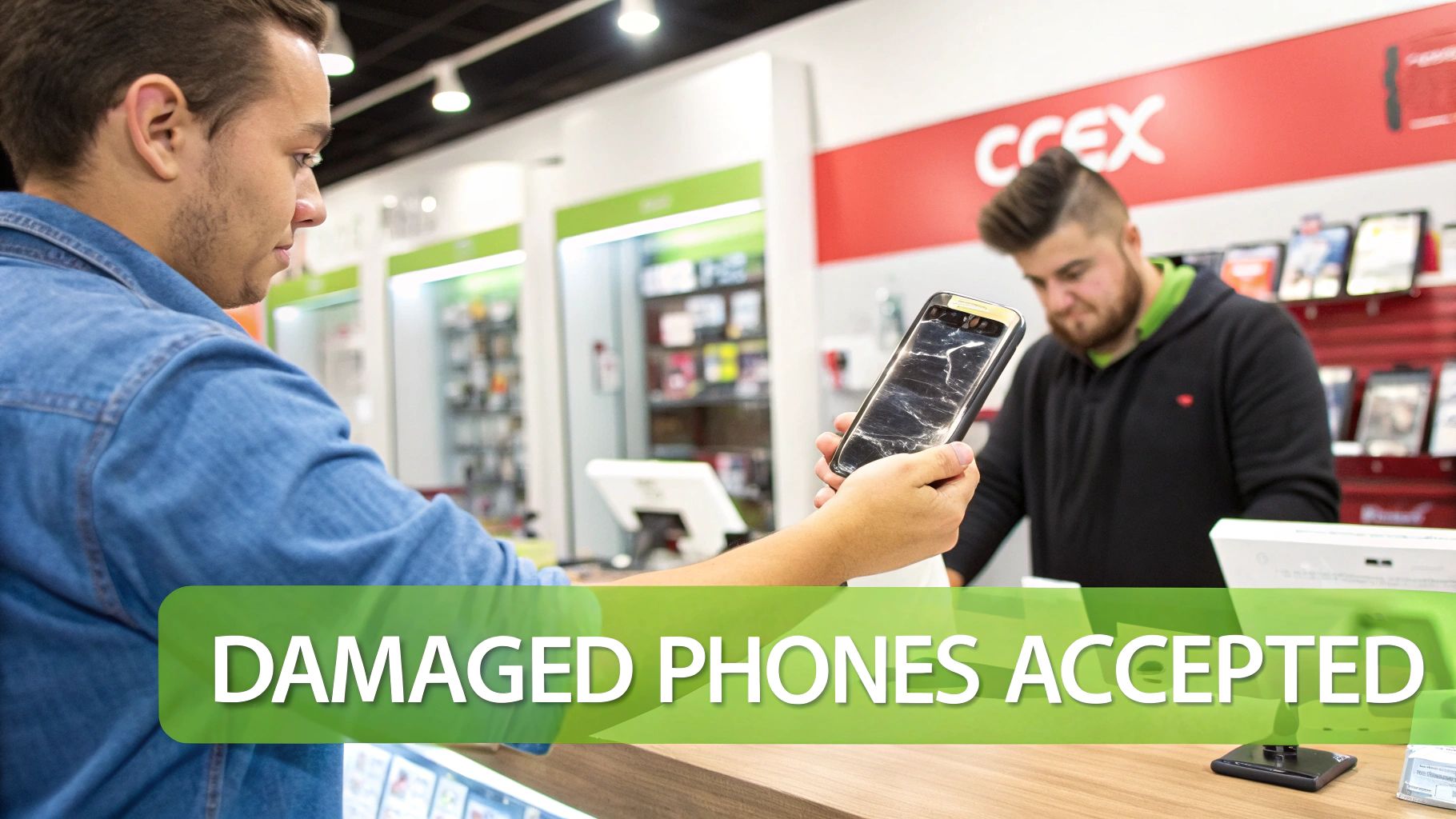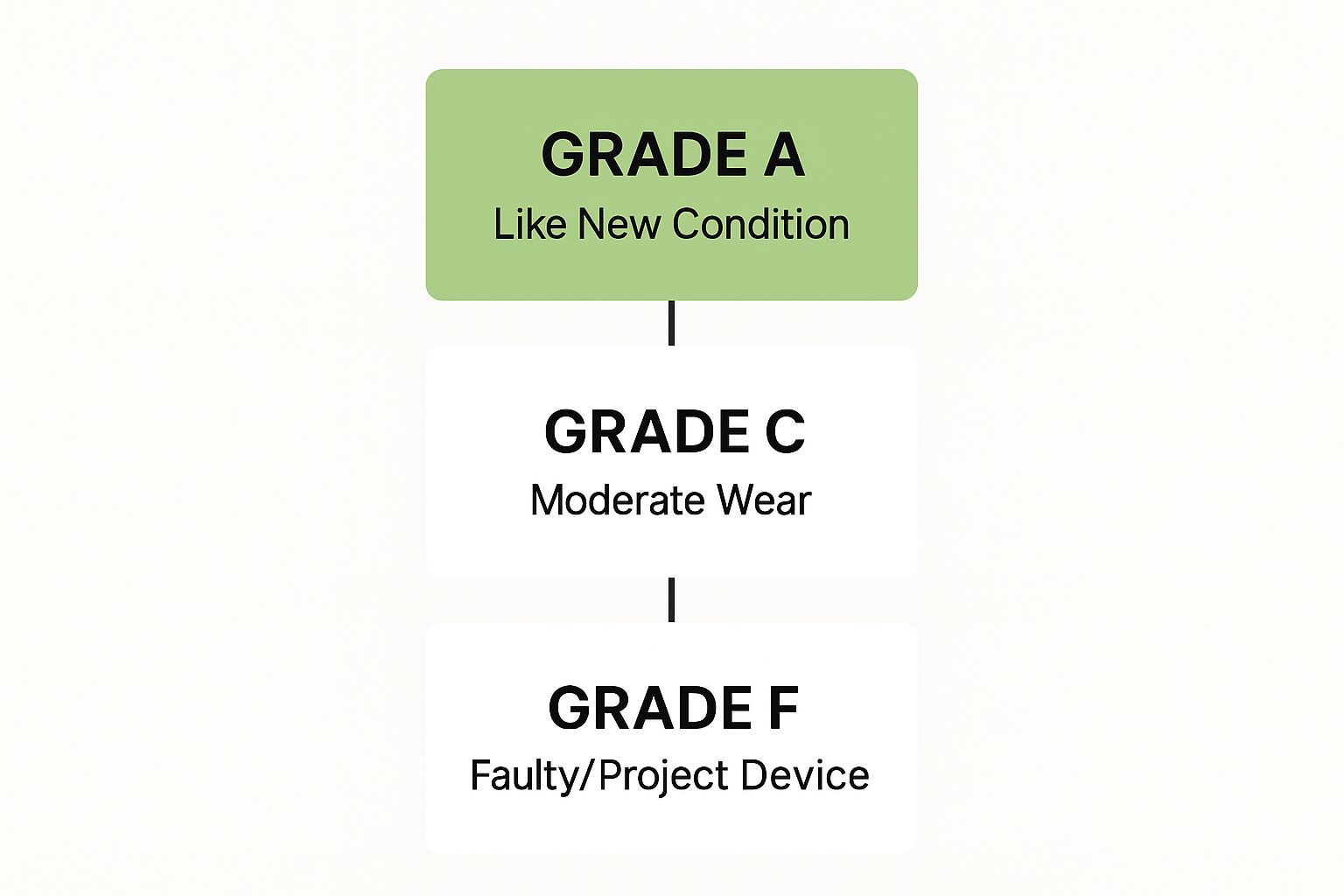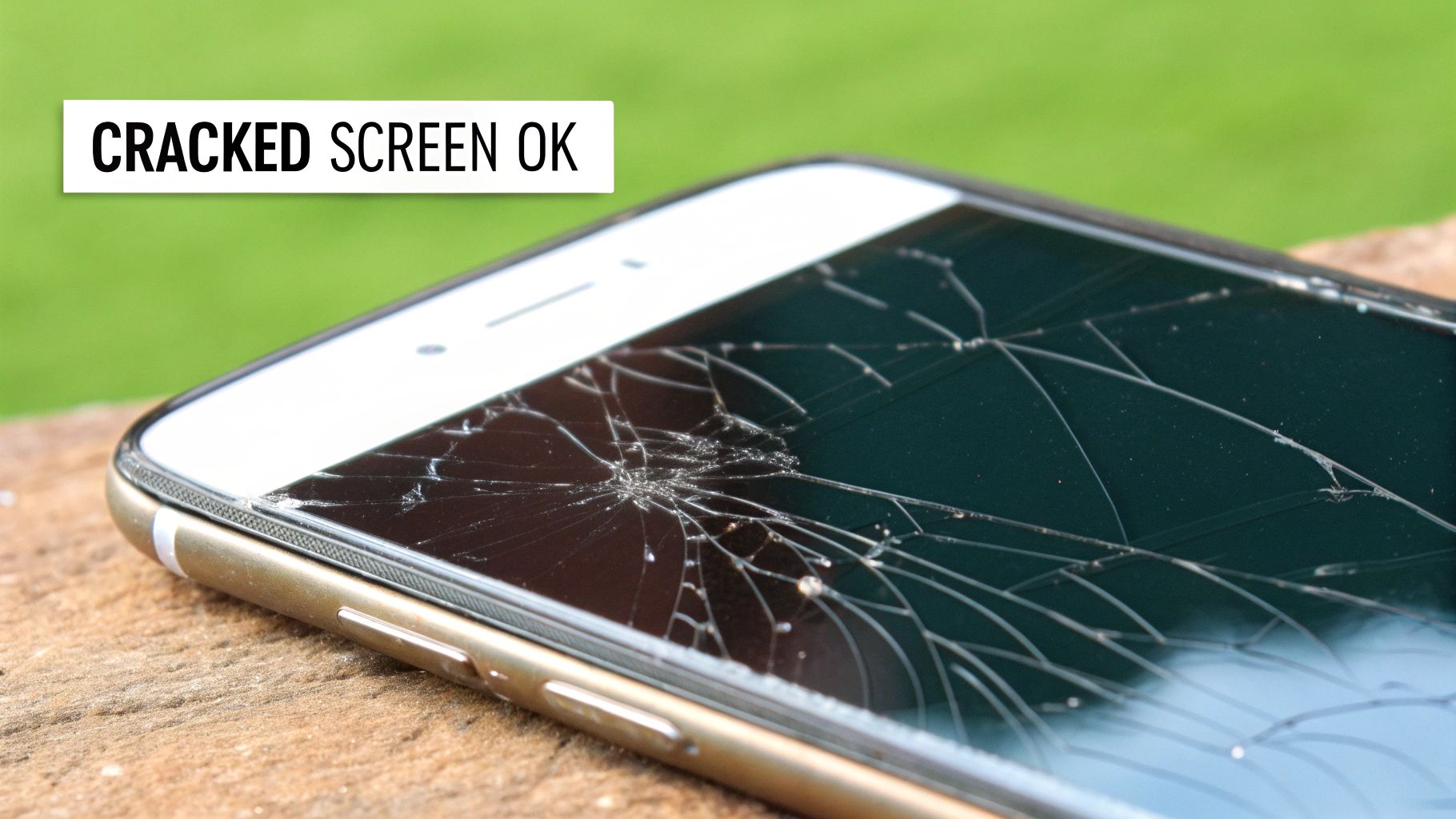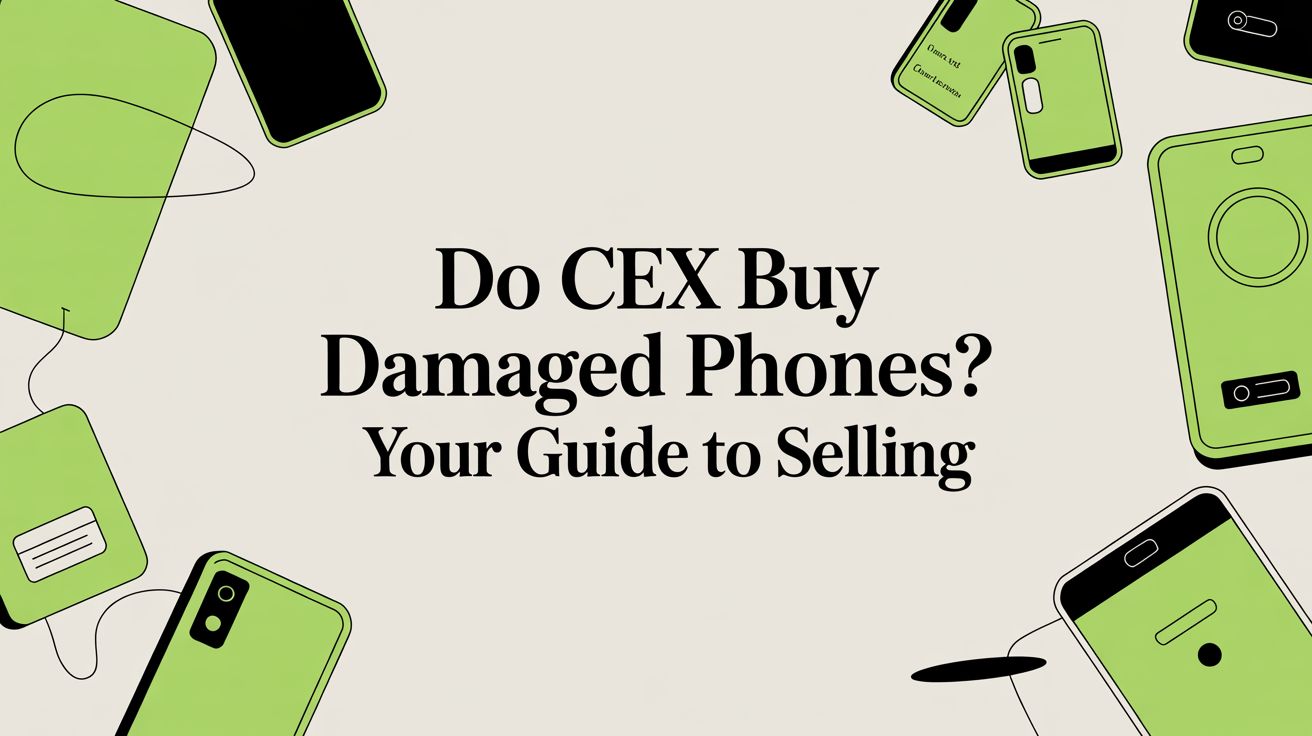So, you've got a phone that's seen better days and you’re wondering, "Will CeX actually buy this?" The short answer is yes, sometimes they do. But it's not a free-for-all.
Whether they'll take your phone really boils down to how broken it is. A simple cracked screen might be perfectly fine, but serious water damage is usually a deal-breaker.
The Straight Answer on Selling Damaged Phones to CeX

To get why CeX is selective, you just need to think about how they operate. Their whole business is built on buying second-hand tech, fixing it up, and selling it on. If your phone has a common, fixable problem, they see an opportunity to make a profit. But if it's a total write-off, it's just a headache for them.
It's a bit like selling a used car. A dealer will happily take one with a few scratches or a worn-out tyre because those are easy fixes. But a car with a seized engine? That's a different story. For CeX, a cracked screen or a tired battery on a popular phone is just a scratch—something their technicians can sort out.
What CeX Typically Looks For
Damaged phones that CeX does buy are categorised under their lowest grade, known as ‘F’ grade (Faulty). For your phone to make the cut, it needs to be worth their while to repair.
Here’s a rough idea of what they’ll probably take and what they'll likely turn away:
- Often Accepted: Cosmetic damage is usually okay. Think deep scratches, dents, and scuffs. They'll often take a phone with a single cracked screen too, as long as the display underneath still works.
- Sometimes Accepted: Minor functional problems can be acceptable. Things like a dodgy charging port, buttons that don't respond, or a battery that dies too quickly might pass the test.
- Almost Always Rejected: This is where the deal-breakers come in. Severe water damage, a bent or snapped frame, or a phone that’s completely dead are almost certain rejections. The same goes for any device that is still iCloud or Google locked.
The bottom line is this: if the cost to fix your phone is less than what they can sell it for, you've got a decent shot. But if it's beyond economical repair, CeX will almost certainly say no.
Let's quickly summarise what CeX looks for when assessing a damaged phone.
CEX Damaged Phone Acceptance Summary
Keeping these points in mind will help you figure out if it's worth taking a trip to your local store.
How the CEX Grading System Really Works
To figure out if CeX will take your damaged phone, you first need to understand how they see it. CeX uses a grading system to work out a phone's value, and that grade is the biggest factor in what they’ll offer you.
Think of it like selling a used car. A Grade ‘A’ phone is like a car that's practically new, straight off the forecourt with barely a mile on the clock. It’s pristine and fetches the top price.
A Grade ‘C’ device, on the other hand, is more like a reliable family runaround. It’s been used and has a few signs of wear and tear—maybe some light scratches or scuffs—but it works perfectly. It’s a dependable workhorse.
Where Do Damaged Phones Fit In?
This is where it gets interesting for anyone with a broken device. Your damaged phone will almost certainly fall into the ‘F’ (Faulty) grade. This category is for gadgets that have real functional problems but aren't a total write-off. Think of an ‘F’ grade phone as a project; it has potential but needs some work before it can be sold again.
This simple hierarchy shows how CeX slots devices into different tiers, from flawless to faulty.

The main thing to remember is that ‘Faulty’ is its own official category. This means CeX has a specific process for pricing up damaged but fixable items.
That said, the final valuation can sometimes feel a bit subjective. We’ve heard from customers who were offered very little for issues like 'screen burn' on phones they thought were in great shape. It just goes to show that the individual grader's assessment on the day plays a huge role in the final price, especially for a damaged phone.
The ‘F’ grade isn’t just a bin for any broken device. It’s specifically for phones where the cost of repair is low enough for CeX to fix it up and still make a profit. If the repair is too complicated or expensive, they'll likely reject your phone completely.
To get a better feel for how retailers generally assess a phone's condition, it’s worth looking at a broader resource like this Second Hand iPhones Grading Guide. Understanding these standards will help you make a more realistic guess at your phone's grade before you even head to the store.
What Phone Damage CeX Is Likely to Accept

So, will CeX actually buy your damaged phone? It all boils down to a simple bit of maths for them: can they fix it and still make a profit? Think of it less about the specific damage and more about the economics of the repair. Your phone is a bundle of parts, and if the working components are valuable enough to cover the cost of fixing the broken ones, you're probably in with a chance.
For example, a cracked screen on a fairly new and popular iPhone is usually an easy sell. The parts are everywhere, and the repair is a routine job for a technician. But that same crack on an older, less common Android phone? That might be a different story. If sourcing a replacement screen is expensive or a massive hassle, they’ll likely turn it down.
Common Acceptable Damage
At the end of the day, CeX is making a business decision. They’re investing in your broken phone, hoping to get a return. This means they're far more likely to take phones with common, straightforward faults that they see all the time.
Here are a few of the issues that will typically land you an ‘F’ grade valuation:
- Cracked Screens: This is probably the most common one. As long as the display underneath the cracked glass still lights up and responds, you should be fine.
- Battery Issues: A battery that dies in a couple of hours or won't hold a charge is a simple fix for their repair team.
- Faulty Buttons: Power buttons or volume controls that have stopped clicking are usually a replaceable part.
- Camera Problems: If the lens is cracked or the camera just won't focus, it's often a case of swapping out the camera module.
- Deep Scratches or Dents: Heavy cosmetic damage doesn't stop the phone from working, so it just pushes the device into a lower grade.
The key thing to remember is that CeX loves predictability. A broken screen has a known repair cost. A phone that won’t turn on at all is a complete mystery box, and they’re not in the business of gambling.
Damage That Leads to Rejection
On the flip side, some types of damage are just too risky or expensive, making your phone a bad investment for them. These are the red flags that will almost certainly get you a "no thanks" at the counter.
Any phone that’s bent, snapped in half, or has obvious, serious water damage is a definite non-starter. The same goes for a device that is completely dead and won’t show any signs of life. These issues often point to a fried logic board—the phone’s brain—and that's almost always too costly and complicated to be worth repairing.
Getting Your Damaged Phone Ready to Sell
Before you pop down to the store, a little prep work can make all the difference. Spending just a few minutes getting your phone ready not only keeps your personal info safe but also helps the whole process run smoothly, hopefully getting you the best price without any fuss.
If your phone still turns on and you can use the screen, back up everything you want to keep. This is your final opportunity to save your photos, contacts, and anything else important. Use a cloud service like iCloud or Google Photos, or just plug it into a computer and drag the files across.
Wiping It Clean and Protecting Your Privacy
With your data safely backed up, the next step is a big one: wiping the phone completely. This is non-negotiable for CeX. They simply can’t buy a phone that still has personal data on it, as it's a huge security risk.
The best way to do this is with a factory reset. You'll usually find this option in your 'Settings' app, often tucked away under 'System' or 'General Management'. This will erase everything and return the phone to the state it was in when you first took it out of the box.
Don't Forget This! Make sure you sign out of your iCloud or Google account before hitting that reset button. If you forget, the phone stays locked to your account, and CeX won't be able to buy it. This is probably the most common reason they have to turn phones away.
Final Checks Before You Head Out
Okay, the digital side is sorted. Now for a couple of quick physical checks. Taking care of these little things makes the process faster and shows you've come prepared.
Here's a quick checklist to tick off:
- Take Your SIM Card Out: This little chip is tied to your phone number and plan. Pop it out and keep it safe.
- Remove Your Memory Card: If your phone has a microSD card for extra storage, don't forget to remove that too.
- Find Any Accessories: Still have the original box, charger, or cable? Grab them. It's not essential, especially for a faulty phone, but sometimes including them can sweeten the deal a tiny bit.
What to Do When CEX Rejects Your Phone

Getting a "no" from CEX can be frustrating, but it definitely doesn't mean your damaged phone is worthless. All it means is that their particular business model, which is geared towards easy refurbishment and resale, isn't the right match for your device in its current state.
Think of it like this: CEX is a bit like a mainstream car dealership that only wants cars needing a quick polish before they go on the forecourt. But your phone might be a "project car" – something that a specialist mechanic or a private enthusiast would be keen to buy. Your job is simply to find the right kind of buyer.
Exploring Your Alternatives
When CEX turns your phone down, it's usually because the fix is just too complicated or expensive for their standard process. This isn't unusual. Many of the big UK trade-in platforms are set up the same way, and they aren’t equipped to deal with heavily damaged tech.
In fact, customer reviews show that up to 95% of complaints about some major retailers are about not getting a fair price for phones with even tiny issues. With typical repair costs ranging from £30 to £170, fixing it yourself first rarely makes financial sense. You can see more about the problems customers run into with major UK trade-in platforms over at Reviews.io.
So, what are your best options?
- Specialist Buyback Services: Companies like EXE have built their entire business around buying the tech that high street shops reject. They have the expertise to repair more complex faults or salvage valuable components, so they can often give you cash for phones CEX won't touch.
- Online Marketplaces: Platforms like eBay and Facebook Marketplace let you sell directly to other people. By listing your phone "for parts or not working," you can connect with professional repairers or hobbyists who are actively looking for specific parts to fix other devices.
- Local Repair Shops: Don't forget your local, independent phone repair shop. These businesses often buy broken phones to strip for genuine parts like screens, batteries, or camera modules, which are invaluable for their own repair work.
The key takeaway is that a rejection from one buyer doesn't define your phone's value. It just means you need to connect with a different type of buyer—one who specialises in unlocking the potential of damaged electronics.
Comparing Options for Selling a Damaged Phone
To help you decide, let's break down the main alternatives to CEX for selling your broken phone here in the UK.
Each option has its pros and cons, so think about what’s most important to you: the highest possible price, the fastest sale, or the least amount of effort.
Here’s the rewritten section, designed to sound completely human-written and natural.
Why Most Big Shops Won’t Touch Damaged Phones
Ever tried to trade in a phone with a cracked screen at a high-street shop, only to be turned away? It’s a common story. It's nothing personal, though; it all comes down to their business model, which is built on speed and simplicity.
These big retailers want phones they can flip quickly. Their entire system is set up to take in working devices, give them a quick data wipe and a polish, and get them back on sale. A phone that’s good to go fits this slick, efficient process perfectly. It's a straightforward, low-risk deal for them.
The Headache of Repairs
A damaged phone, on the other hand, is a real spanner in the works. It needs a proper diagnosis, someone has to find the right parts, and a skilled technician has to spend time on the repair. All of that introduces costs and delays they just aren't set up for.
Take Carphone Warehouse, for instance. Their policy is crystal clear: no damaged phones for trade-in. They expect devices to be in good nick, meaning no cracked screens, no water damage, and it has to power on properly. They do offer a repair service, with costs ranging from £29.99 to £169.99, but that's a completely separate thing. You have to get it fixed before you can even think about trading it in. You can read up on Carphone Warehouse’s specific trade-in requirements yourself.
This is exactly what makes CeX stand out. Where most retailers see a broken phone as a problem to be avoided, CeX sees potential. For them, it’s all about whether the numbers add up on the repair.
This context is key. It explains why your best bet for a damaged phone isn’t a major retailer, but a specialist buyer who has the skills and setup to handle the repairs the big shops run a mile from.
Still got a few things on your mind about selling that damaged phone? No problem. Let's run through some of the most common questions people ask.
Will CeX Take a Water-Damaged Phone?
Honestly, it's highly unlikely. CeX tends to steer clear of water damage because it’s a real wild card. The corrosion it causes inside a phone can be a ticking time bomb, leading to complete failure weeks or even months down the line.
Even if your phone seems to be working fine after a dunking, they’ll almost certainly reject it. The internal risk is just too high for them to take on.
Do I Need the Box and All the Bits?
Nope, you don't need them. This is especially true when you're selling a faulty phone that’s going to get an ‘F’ grade anyway.
For a perfectly working phone, having the original box and charger might bump up the price a tiny bit. But for a damaged one? It makes virtually no difference. CeX is only interested in what it'll cost them to fix it or what parts they can salvage.
Can I Get Actual Cash, or Is It Just Vouchers?
You can absolutely get cash. CeX gives you three ways to get paid: cash in hand, a CeX voucher, or a direct exchange for something else in the shop.
Just be aware that they always offer a better deal if you take the voucher. The cash offer for a faulty phone can be pretty low, so think about whether the extra store credit might be more valuable to you in the long run.
At the end of the day, the final say rests with the CeX staff in the shop. They'll give the phone a proper inspection before they can tell you for sure if they’ll buy it and for how much.
What ID Do I Need to Bring?
You'll need to be over 18 and show some valid ID to sell anything to CeX. It's a legal thing to help stop the sale of stolen goods.
Make sure you bring one of these with you:
- A current passport
- A UK photocard driving licence
- An EU national identity card
Without the right ID, they can’t complete the sale, so don't forget it!
If dealing with CeX sounds like too much hassle, or you just want a straightforward cash offer without the guesswork, EXE is your answer. We specialise in buying the tech that others turn away.
You can get a fast, fair, and secure quote for your damaged phone today at our website: Get a quote from EXE.
Article created using Outrank











